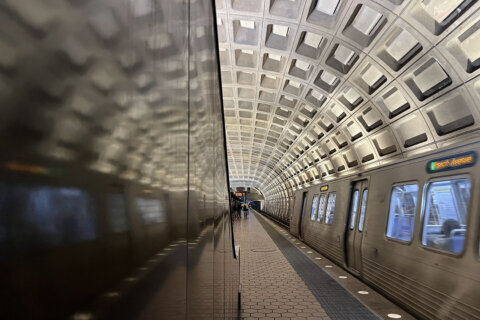WASHINGTON — Metro track inspectors copied the same details over and over for months, even years, regarding the condition of the tracks outside the East Falls Church Station, where a train derailed in July, and told investigators that they were pressured not to accurately report the severity of track conditions.
The details were included in reports released Thursday by the National Transportation Safety Board following the federal agency’s findings into the derailment. The documents suggest at least two people could be fired. A police investigation into the incident is ongoing.
Metro’s ineffective track inspection program, which allowed the wooden crossties to crumble and rot, was to blame for the derailment.
Fifteen times this year and 34 times in 2015, Metro track inspection reports show the exact same note: “15 deteriorating ties in the diamond area” of the interlocking outside of East Falls Church Station — the same spot where the derailment occurred.
In interviews with track inspectors, Metro safety officer Robert Davis who worked for years at Amtrak, said the same exact measurements for the width and angle of the track in the area appeared to have been copied over from as far back as 2011. The tracks would typically move a bit month to month due to regular use from the trains running over them. No change was ever recorded.
One track inspector admitted that if it rained or if he was assigned too much to actually accomplish, that some inspections would be skipped. Both inspectors, whose interviews with the Metro safety officer were made public, said that no Metro inspectors had known they were supposed to be regularly checking the center of interlockings on a twice-weekly basis.
Fixing crumbling crossties has been a focus of Metro’s surge of recent repair work. And Metro has recently increased training and brought in outside consultants to improve its track inspection program.
In the July derailment, weak ties allowed rail spikes to slip out “like butter,” Davis said.
Inspectors detail pushback
Two inspectors interviewed as part of the derailment probe said that they would get pushback, and in some cases face retaliation, when they reported problems along the tracks.
Jovito Azurin, 50, who has worked at Metro for 16 years, blamed supervisors for at least some of the issues when confronted with reports he signed that showed the exact same measurements were detailed in reports twice in 2013, four times in 2014, four times in 2015 and once in 2016.
Azurin said he was told not to enter any changes to the measurements.
In some cases, Azurin said, information on inspection reports were largely preprinted for inspectors. He said he was sometimes assigned far more switches to inspect than he could physically get to in the given time.
Both Azurin and another inspector, Trapp Thomas, said that supervisors would get upset if a problem was identified as one serious enough to slow down trains or take the track out of service if the issue had not been slowly escalated up Metro’s defect reporting system.
“You solved the problem. You prevented something from happening. That’s not how it was looked at. It’s, well, why didn’t you find it before,” Thomas said according to the transcripts.
Thomas, who has worked for Metro for nine years following nine years at New York City Transit, said many of the defects were not always dealt with.
“It never gets addressed until something breaks, until there’s a crack,” Thomas said.
Thomas found more than 180 “red conditions” in a single inspection of one of the two main Orange Line tracks near East Falls Church just before a recent round of work began there.
A red condition is the second most serious and typically requires repairs or train slowdowns. It took him three days to enter all the issues into Metro’s defect database.
“I’ve seen people underreport, not just ignore,” Thomas said. “Nobody ignores anything. But they’ll — when something is a red, they may say it’s yellow. And all of that is dangerous.”
Thomas said that the 15 defective ties listed on inspection reports he was a part of in 2015 and 2016 at the location of the derailment may have been the same issues he reported five years earlier.
On the Blue and Yellow lines near Reagan National Airport, Thomas said a supervisor told him to ignore some problems and even took him for drug and alcohol testing as part of an effort to discredit Thomas’s reports of issues.
“He’s saying, with his experience, he — his experience gives him the ability to create a gray area, which means to ignore what’s in the book,” Thomas said according to the transcripts.
An interview transcript shows that safety officer Davis indicated at least two supervisors would be fired in connection with this derailment.
General Manager Paul Wiedefeld would not comment Thursday on whether anyone had been fired and he declined to comment on the status of the Metro Transit Police investigation into the derailment, which is believed to be partially focused on the potentially falsified inspection reports.
Wiedefeld told reporters Thursday he feels Metro is turning the issues tied to retaliation around. The general manager has cited an increase in speed restrictions across the system since the derailment as a sign that workers and supervisors are taking safety more seriously.
Wiedefeld said he planned to provide an update in two weeks.





